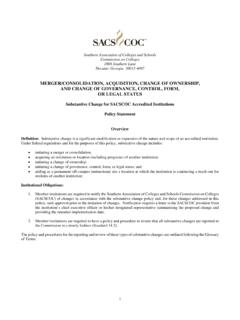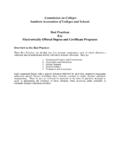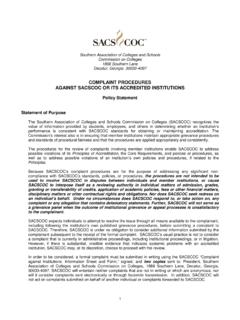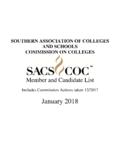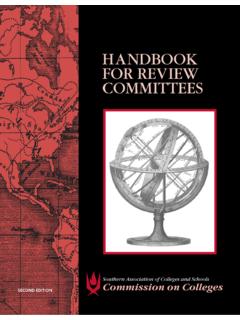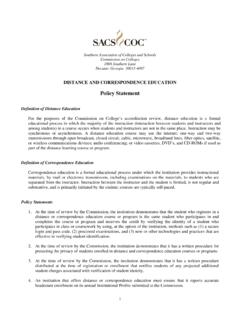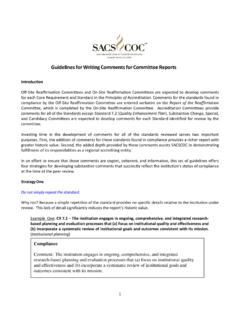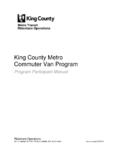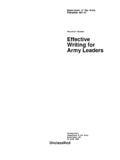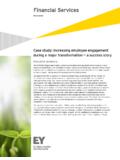Transcription of SUBSTANTIVE CHANGE FOR SACSCOC ACCREDITED …
1 1 Southern Association of Colleges and Schools Commission on Colleges 1866 Southern Lane Decatur, Georgia 30033-4097 SUBSTANTIVE CHANGE FOR SACSCOC ACCREDITED INSTITUTIONS Policy Statement Institutional Obligations: 1. Member institutions are required to notify the Southern Association of Colleges and Schools Commission on Colleges ( SACSCOC ) of changes in accordance with the SUBSTANTIVE CHANGE policy and, when required, seek approval prior to the initiation of changes. 2. Member institutions are required to have a policy and procedure to ensure that all SUBSTANTIVE changes are reported to the Commission in a timely fashion. Definition: SUBSTANTIVE CHANGE is a significant modification or expansion of the nature and scope of an ACCREDITED institution. Under federal regulations, SUBSTANTIVE CHANGE includes Any CHANGE in the established mission or objectives of the institution Any CHANGE in legal status, form of control, or ownership of the institution The addition of courses or programs that represent a significant departure, either in content or method of delivery, from those that were offered when the institution was last evaluated The addition of courses or programs of study at a degree or credential level different from that which is included in the institution s current accreditation or reaffirmation.
2 A CHANGE from clock hours to credit hours A substantial increase in the number of clock or credit hours awarded for successful completion of a program The establishment of an additional location geographically apart from the main campus at which the institution offers at least 50% of an educational program. The establishment of a branch campus Closing a program, off-campus site, branch campus or institution Entering into a collaborative academic arrangement that includes only the initiation of a dual or joint academic program with another institution Acquiring another institution or a program or location of another institution Adding a permanent location at a site where the institution is conducting a teach-out program for a closed institution Entering into a contract by which an entity not eligible for Title IV funding offers 25% or more of one or more of the ACCREDITED institution s programs The SACSCOC Board of Trustees has approved additional SUBSTANTIVE changes that require notification and, in some cases, approval prior to implementation.
3 This policy and its procedures address SUBSTANTIVE changes identified through Federal regulations and Board approval. 2 Table of Contents Glossary of Terms .. 3 The Policy .. 5 Commission Responsibilities .. 5 Institutional Responsibilities .. 5 Procedures for Reporting SUBSTANTIVE Changes: An Overview .. 5 Reporting the Various Types of SUBSTANTIVE CHANGE .. 6 Required Committee Visits .. 11 Policy Statements .. 12 Fees and Expenses .. 14 Procedure One: .. 15 The Review of SUBSTANTIVE Changes Requiring Approval Prior to Implementation Procedure Two: .. 20 The Review of SUBSTANTIVE Changes Requiring Only Notification Prior to Implementation Procedure Three: .. 22 Closing a Program, Site, Branch Campus or Institution Appendices Appendix A: Current Standards and Policy Statements Addressing .. 24 Unreported SUBSTANTIVE CHANGE Appendix B: The Content of the SUBSTANTIVE CHANGE Prospectus .. 26 3 Glossary of Terms Branch campus - a location of an institution that is geographically apart and independent of the main campus of the institution.
4 A location is independent of the main campus if the location is permanent in nature offers courses in educational programs leading to a degree, certificate, or other recognized educational credential has its own faculty and administrative or supervisory organization and has its own budgetary and hiring authority Contractual Agreement typically is one in which an institution enters an agreement for receipt of courses/ programs or portions of courses or programs ( , clinical training internships, etc.) delivered by another institution or service provider. Consortial Relationship - A consortial relationship typically is one in which two or more institutions share in the responsibility of developing and delivering courses and programs that meet mutually agreed upon standards of academic quality. Correspondence education - a formal educational process under which the institution provides instructional materials, by mail or electronic transmission, including examinations on the materials, to students who are separated from the instructor.
5 Interaction between the instructor and the student is limited, is not regular and SUBSTANTIVE , and is primarily initiated by the student; courses are typically self-paced. Degree completion program a program typically designed for a non-traditional undergraduate population such as working adults who have completed some college-level course work but have not achieved a baccalaureate degree. Students in such programs may transfer in credit from courses taken previously and may receive credit for experiential learning. Courses in degree completion programs are often offered in an accelerated format or meet during evening and weekend hours, or may be offered via distance learning technologies. Direct Assessment Competency-Based Educational programs - Federal regulations define a direct assessment competency-based educational program as an instructional program that, in lieu of credit hours or clock hours as a measure of student learning, uses direct assessment of student learning relying solely on the attainment of defined competencies, or recognizes the direct assessment of student learning by others.
6 The assessment must be consistent with the accreditation of the institution or program using the results of the assessment. Distance education - a formal educational process in which the majority of the instruction (interaction between students and instructors and among students) in a course occurs when students and instructors are not in the same place. Instruction may be synchronous or asynchronous. A distance education course may use the internet; one-way and two-way transmissions through open broadcast, closed circuit, cable, microwave, broadband lines, fiber optics, satellite, or wireless communications devices; audio conferencing; or video cassettes, DVD s, and CD-ROMs if used as part of the distance learning course or program. Dual degree separate program completion credentials each of which bears only the name, seal, and signature of the institution awarding the degree to the student. Educational program a coherent course of study leading to the awarding of a credential ( , a degree, diploma or certificate).
7 Geographically separate - an instructional site or branch campus that is located physically apart from the main campus of the institution. Joint degree - a single program completion credential bearing the names, seals, and signatures of each of the two or more institutions awarding the degree to the student. 4 Modified prospectus - a prospectus submitted in lieu of a full prospectus for certain designated SUBSTANTIVE changes. When a modified prospectus is acceptable, the Commission specifies requested information from the institution. Notification - a letter from an institution s chief executive officer, or his/her designated representative, to SACSCOC President summarizing a proposed CHANGE , providing the intended implementation date, and listing the complete physical address if the CHANGE involves the initiation of an off-campus site or branch campus. The policy and procedures for reporting and review of institutional SUBSTANTIVE CHANGE are outlined in the document SUBSTANTIVE CHANGE for ACCREDITED Institutions of the Commission on Colleges.
8 Significant departure a program that is not closely related to previously approved programs at the institution or site or for the mode of delivery in question. To determine whether a new program is a significant departure, it is helpful to consider the following questions: What previously approved programs does the institution offer that are closely related to the new program and how are they related? Will significant additional equipment or facilities be needed? Will significant additional financial resources be needed? Will a significant number of new courses will be required? Will a significant number of new faculty members will be required? Will significant additional library/learning resources be needed? Teach-out agreement - a written agreement between institutions that provides for the equitable treatment of students and a reasonable opportunity for students to complete their program of study if an institution, or an institutional location that provides 50% or more of at least one program offered, ceases to operate before all enrolled students have completed their program of study.
9 This applies to the closure of an institution, a site, or a program. Such a teach-out agreement requires SACSCOC approval in advance of implementation. Teach-out plan - a written plan developed by an institution that provides for the equitable treatment of students if an institution, or an institutional location that provides 50% or more of at least one program, ceases to operate before all students have completed their program of study, and may include, if required by the institution's accrediting agency, a teach-out agreement between institutions. This applies to the closure of an institution, a site, or a program. Teach-out plans must be approved by SACSCOC in advance of implementation. 5 The Policy Commission Responsibilities The Southern Association of Colleges and Schools Commission on Colleges ( SACSCOC ) accredits an entire institution and its programs and services, wherever they are located or however they are delivered.
10 It is responsible for reviewing all SUBSTANTIVE changes that occur between an institution s decennial reviews, determining whether the changes have affected the quality of the total institution, and assuring the public that all aspects of the institution continue to meet defined standards. SACSCOC is recognized by the Department of Education as an agency whose accreditation enables its member institutions to seek eligibility to participate in Title IV programs . To maintain its recognition with the Department of Education, SACSCOC has incorporated federal requirements into its SUBSTANTIVE CHANGE policy and procedures. Some of those requirements specify that an institution seek and receive approval prior to the initiation of a SUBSTANTIVE CHANGE so that the CHANGE can be included in the institution s scope of accreditation. Institutional Responsibilities It is the responsibility of an institution to follow SACSCOC SUBSTANTIVE CHANGE procedures and inform SACSCOC of SUBSTANTIVE changes as specified in those procedures.
